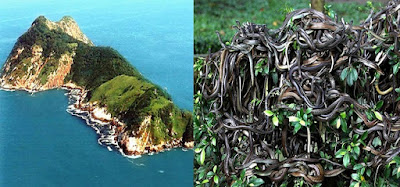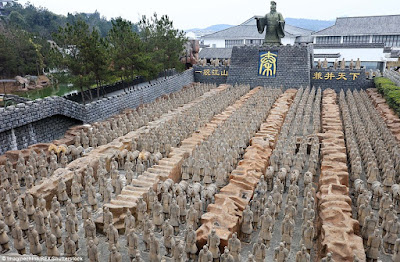Stonehenge (The wonder of the world)
Stonehenge was produced by a culture that left
no written records. Many aspects of Stonehenge, such as how it was built and
which purposes it was used for, remain subject to debate. A number of myths
surround the stones. The site, specifically the great trilithon, the
encompassing horseshoe arrangement of the five central trilithons, the heel
stone, and the embanked avenue, are aligned to the sunset of the winter solstice
and the opposing sunrise of the summer solstice. A natural landform at the
monument's location followed this line, and may have inspired its construction.
The excavated remains of culled animal bones suggest that people may have
gathered at the site for the winter rather than the summer. Further
astronomical associations, and the precise astronomical significance of the
site for its people, are a matter of speculation and debate.
There is little or no direct evidence revealing the construction
techniques used by the Stonehenge builders. Over the years, various authors
have suggested that supernatural or anachronistic methods were used, usually
asserting that the stones were impossible to move otherwise due to their
massive size. However, conventional techniques, using Neolithic technology as
basic as shear legs, have been demonstrably effective at moving and
placing stones of a similar size. How the stones could be transported by a
prehistoric people without the aid of the wheel or a pulley system is not
known. The most common theory of how prehistoric people moved megaliths has
them creating a track of logs on which the large stones were rolled along. Another
megalith transport theory involves the use of a type of sleigh running on a
track greased with animal fat. Such an experiment with a sleigh carrying a
40-ton slab of stone was successful near Stonehenge in 1995. A team of more
than 100 workers managed to push and pull the slab along the 18-mile
(29 km) journey from Marlborough Downs. Proposed functions for the
site include usage as an astronomical observatory or as a religious site.
HISTORY OF STONEHENGE BY HISTORY
Stonehenge
is the handiwork of the wizard Merlin.
In the mid-fifth century, the story goes, hundreds of British nobles were
slaughtered by the Saxons and buried on Salisbury Plain. Hoping to erect a
memorial to his fallen subjects, King Aureoles Ambrosias sent an army to
Ireland to retrieve a stone circle known as the Giants’ Ring, which ancient
giants had built from magical African bluestones. The soldiers successfully
defeated the Irish but failed to move the stones, so Merlin used his sorcery to
spirit them across the sea and arrange them above the mass grave. Legend has it
that Ambrosias and his brother Uther, King Arthur’s father, are buried there as
well.
While many believed Monmouth’s account to be the true story of
Stonehenge’s creation for centuries, the monument’s construction predates
Merlin—or, at least, the real-life figures who are said to have inspired him—by
several thousand years. Other early hypotheses attributed its building to the
Saxons, Danes, Romans, Greeks or Egyptians. In the 17th century, archaeologist
John Aubrey made the claim that Stonehenge was the work of the Celtic high
priests known as the Druids, a theory widely popularized by the antiquarian
William Stukeley, who had unearthed primitive graves at the site. Even today,
people who identify as modern Druids continue to gather at Stonehenge for the
summer solstice. However, in the mid-20th century, radiocarbon dating
demonstrated that Stonehenge stood more than 1,000 years before the Celts
(The Celts were a collection of tribes with
origins in central Europe that shared a similar language, religious beliefs,
traditions and culture. It’s believed that the Celtic culture started to evolve
as early as 1200 B.C. The Celts spread throughout western Europe—including
Britain, Ireland, France and Spain—via migration. Their legacy remains most
prominent in Ireland and Great Britain, where traces of their language and
culture are still prominent today.) inhabited the region, eliminating the ancient Druids from the running.
Two major new theories have been proposed.
Professor Geoffrey Wainwright, president of the Society of Antiquaries of London, and Timothy Darvill,
of Bournemouth University, have suggested that Stonehenge was a
place of healing—the primeval equivalent of Lourdes. They argue
that this accounts for the high number of burials in the area and for the
evidence of trauma deformity in some of the graves. However, they do concede
that the site was probably multifunctional and used for ancestor worship as
well. Isotope analysis indicates that some of the buried individuals were from
other regions. A teenage boy buried approximately 1550 BC was raised near the
Mediterranean Sea; a metal worker from 2300 BC dubbed the "Amesbury
Archer" grew up near the alpine foothills of Germany; and the
"Boscombe Bowmen" probably arrived from Wales or Brittany, France.
On the other hand, Mike Parker Pearson of Sheffield
University has suggested that Stonehenge was part of
a ritual landscape and was
joined to Durrington Walls by their corresponding avenues and the River Avon.
He suggests that the area around Durrington Walls Henge was a place of the
living, whilst Stonehenge was a domain of the dead. A journey along the Avon to
reach Stonehenge was part of a ritual passage from life to death, to celebrate
past ancestors and the recently deceased. Both explanations were first
mooted in the twelfth century by Geoffrey of
Monmouth, who extolled the curative properties of the stones
and was also the first to advance the idea that Stonehenge was constructed as a
funerary monument. Whatever religious, mystical or spiritual elements were
central to Stonehenge, its design includes a celestial observatory function,
which might have allowed prediction of eclipse, solstice, equinox and other
celestial events important to a contemporary religion
There are other hypotheses and theories.
According to a team of British researchers led by Mike Parker Pearson of the
University of Sheffield, Stonehenge may have been built as a symbol of
"peace and unity", indicated in part by the fact that at the time of
its construction, Britain's Neolithic people were experiencing a period of
cultural unification.
Researchers from the Royal College of Art in
London have discovered that the monument’s bluestones possess "unusual
acoustic properties" — when struck they respond with a "loud
clanging noise". According to Paul Devereux, editor of the journal Time
and Mind: The Journal of Archaeology, Consciousness and Culture, this idea
could explain why certain bluestones were hauled nearly 200 miles
(320 km)—a major technical accomplishment at the time. In certain ancient
cultures rocks that ring out, known as lithophones
[A lithophone is a musical instrument consisting of a rock or
pieces of rock which are struck to produce musical notes. Notes may be sounded
in combination (producing harmony) or in succession (melody). The lithophone is
an idiophone similar
to the bars on instruments such as the glockenspiel, metallophone, xylophone and marimba., were
believed to contain mystic or healing powers, and Stonehenge has a history of
association with rituals].
The presence of these "ringing rocks"
seems to support the hypothesis that Stonehenge was a "place for
healing", as has been pointed out by Bournemouth University archaeologist
Timothy Darvill, who consulted with the researchers. The bluestones of
Stonehenge were quarried near a town in Wales called Maenclochog
(The origin of the name Maenclochog is unclear. It appears to be
made up of two Welsh words, maen ("stone") and clochog ("noisy,
clamorous").A local tale reports that there were stones near Ffynnon Fair
("Mary's Well"), to the south of the village, which rang like bells
when struck, but these were blown to bits by treasure-hunters, in the mistaken
belief that they concealed a golden treasure. This may represent nothing more
than folk etymology. An alternative proposal is that the second part of the
name comes from the Irish word, clochog, meaning a craggy place.
This theory is supported by the fact that there was Irish migration to
Pembrokeshire in the early Middle Ages, as attested to by the Ogham stones
found in the locality and elsewhere, and certainly the name suits the
topography of the area), which
means "ringing
rock", where the local bluestones were used as church bells
until the 18th century.








Comments
Post a Comment
Your suggestions